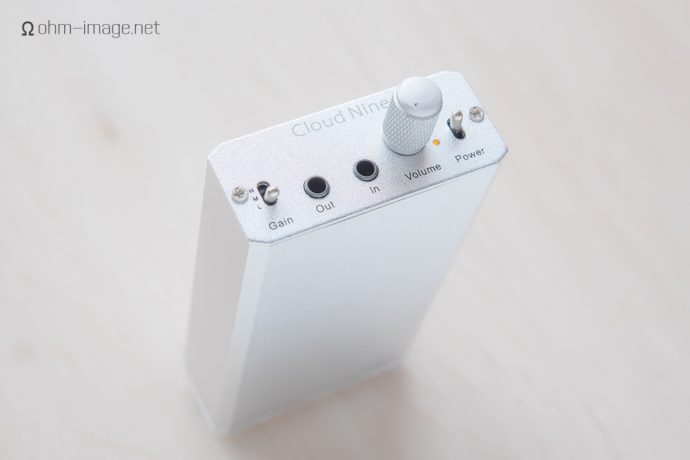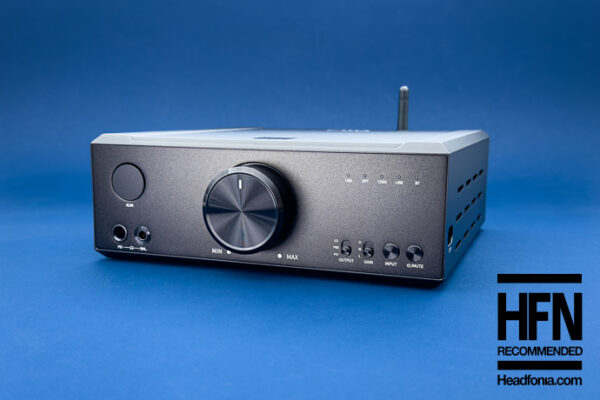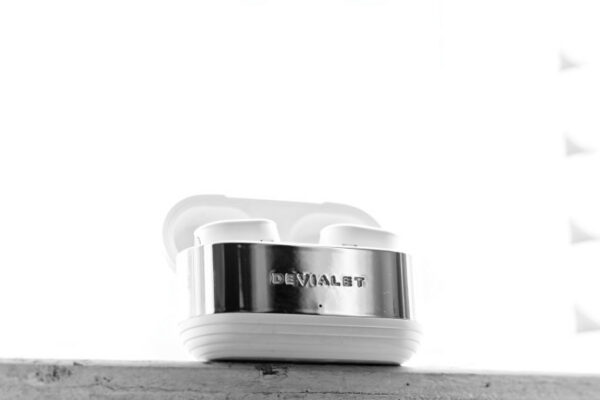Disclaimer: plusSound graciously provided the plusSound Cloud Nine for the purposes of this review. It starts at 349$ USD. You can find out all about it here.
specs
Device Type: Solid State
Battery Type: 9V (x2)
Frequency response: 20hz – 20khz +/-0.1dB
Gain: 1x/0dB, 5x/10dB, 10x/20dB
Input impedance: 50K
Output impedance: <1 ohm
Maximum output: 200mA
Power rating: 1.28W into 32 ohm, 1W into 50 ohm, 250mW into 300 ohm, 120mW into 600 ohm
Noise floor: ~-150dB
THD:~0.0009%
Protection: Reverse battery
Input/Output: 3.5mm Switchcraft / 3.5mm Switchcraft
Dimensions: 2.3″ x 4.5″ x 0.95″
Weight: 3.2 oz (without batteries)
Let’s get physical
Cloud Nine is as close to a moon boot as a portable headphone can be. It starts with the unapologetically mottled finish. It continues with the finely scored battery bolts and almost-holographic labels. Then there’s the easy-sliding gain and power switches that duff rather than click into place. And, like a day spent destroying snow forts, the sallow lamp is all fun and games. Want it by your bedside? No problem. Want to know the amp is still in the day time? Ditto.
And, Cloud Nine is an appealing, if completely anachronistic shape.
I’m most into its 1970s SLR silver finish. Most into it indeed. It makes me miss my old Pentax K1000.
Ergonomically Cloud Nine works: there’s enough space between ins and outs to plug in most modern ins and outs. But, if you’ve got fat interconnects and headphone plugs, Cloud Nine will cramp up. Here’s my opinion: the gain switch should be situated between the ins and outs for a more comfy faceplate.
And the aesthetically pleasing bolts about which plusSound say:
Amplifier features back panel with thumbscrews for easy battery switching.
There ain’t nothing easy about removing, or inserting the battery again. Sure, the batteries spring out when finally you wrench those little buggers away. But trust me, you’ll need a wrench. Or a grade six. They’re positively Lilliputian. And the rear cap really scrunches down on the dual 9V power supply, making it difficult to both handle the batteries, and get the rear cap on with only two hands. And for your trouble? The rear plate slides a bit on its mount.
The bolts holding the faceplate are adequate, but don’t quite fit flush. The firm volume pot grinds a bit on its post: nothing a twirl of the Allen bolt won’t fix. (The torque necessary to twist it is Cloud Nine’s first, and last defense against burning eardrums. And it is way better at that the pot on most portable amps. Applause.)
I guess that’s the problem with moon boots. They look freaking awesome in the club. But your feet? Sweaty messes. Cloud Nine looks great, looks like a car from your childhood, but those looks are accompanied by a few comic bookian quirks that really should be ironed out.
That’s to say that Cloud Nine does NOT say: I’m German-engineered. Nor do they say: I’m haute couture. It says loud and shiny: I’m moon boots, bitches, and you’re in for a ride!
That’s all to say that I LOVE the aesthetic. It’s unique. It’s got this 80’s (1979 October counts, right?) kid dripping with nostalgia. But certain ergonomic compromises were made in the name of moon boots. Se la vie.
The Performance
In case you forgot, I’m Headfi’s hiss king. Sssssssss! Sssssssss! I hate the stuff. It is the biggest reason I give the nod to the MZAK100 mod over the RWAK100, which comes quite a bit cheaper, and is backed by Vinnie Rossi, a long-time friend of portable audio. The MZAK100 simply doesn’t hiss.
And within reason, neither does the Cloud Nine. My hiss-proniest earphones are the Ultrasone IQ. They’ve made me hate some previously loved audio gear. And, yes, they do pick up background noise from the Cloud Nine. But, by the power of Greyskull!, it’s minimal. It is in fact, about on par with the latest generation iPod nano (of which I am a proud owner), which means: only the MZAK100, and maybe the Calyx M have less hiss.
Even when paired with the same Ultrasone IQ, the finger exercise machine that is the volume pot achieves perfect balance between left and right channels almost immediately. That said, its usable volume range, at least for my ears, and when paired with the same earphones, is contained within a 10º turn of the pot. Urbaner earphones will allow more leeway. But that is a problem 99% of portable amps have with the IQ. And Cloud Nine outdoes most them.
Amps with gains more appropriate to the IQ are:
PURE II (ahead by two hairs)
Portaphile Micro (ahead by three hairs)
Cypher Labs Duet (ahead by a half a hair, but far hissier)
Cypher Labs Picollo (simply amazing gain system for sensitive earphones)
Background noise doubles and trebles when switching gain from medium to high. But it is completely commensurate to the power it outputs. Your DT880/600 won’t be bothered by the worst the Cloud Nine can do.
Even on low gain, they can kick out solid, unperturbed, and powerfully backed volume.
As for performance-by-numbers, Cloud Nine is impressive on almost all fronts. One: it provides plenty of current into low impedance loads to keep distortion to a minimum while managing pristine frequency responses. It is an excellent earphone amplifier. In the Sound portion of this review, I will describe what earphones are best suited to it. Low-current, high-voltage headphones like the DT880, to a certain extent, are Cloud Nine’s sweet spot. In particular, the stereo image is extremely wide, and the amp can scale up to the highest signal outputs.
In every single case, the limiting factor (RMAA, not my ears) was the output device, not the Cloud Nine. If an iPod, or an AK device puts out 90dB of dynamic range, so will Cloud Nine. If the iPod or AK puts out 85dB of stereo separation, so will the Cloud Nine. The difference will be that Cloud Nine will keep those numbers even under low-Ω loads, while the AK device will fall by at least 5dB in either metric, and the iPod: it depends. We are talking about a very high-quality output.
But it does sport a low-pass filter, smoothing peaks here, softening crashes there. If you’re a play-by-numbers type that must have absolute signal integrity, hit up the PURE II, which is even Stephen from top to bottom. If you’re in it for the simple pleasure that accompanies a favorite pair of headphones, a comfy chair, a smoldering fire, and whiskey on ice, you are in the market for a really nice low-pass filter. In the section below I’ll outline just how nice the Cloud Nine’s low pass filter is.
Back to power: in low gain, Cloud Nine supplies enough current-backed voltage to power a DT880/600, but only to levels that are slightly louder than safe. On high gain, volume levels safely jump up by ten to fifteen decibels. Those levels are too much for me. But, I know that many of you are in it for the hearing aids. If you’re intent on making this hobby a happy two-year affair before welcoming deafness, you will find that Cloud Nine can’t keep sizzle out of the bass when set to high gain past 3 o’clock on the volume pot. If you want to ruin your ears, other, more powerful amps exist.
But make no mistake: listening to DT880/600 at those volume levels WILL destroy your hearing. It is just a question of when.
By the way, I didn’t properly gauge battery life, but my excellent deductive mind tells me you can get around 30 hours to a charge, if not a bit more. That means like 50 whirls of John Denver’s Farewell Andromeda.
Sound and more continued after the jump:








dalethorn
Maximum power 200 mw, and power at 32 ohms is 1280 mw (1.28 w)??
ohm image
Amaaaazing control and power for earphones and most headphones. Stupendous sound.
dalethorn
I’ve been using the Decware Zen Head ($375) and Portaphile Micro $450-$500) as occasional addons to my small low-cost DACs like the Microstreamer, and they do improve the detail compared to the Microstreamer/Audioengine D3/Dragonfly DACs by themselves. So I’d surmise that this amp fits into the PM or DZH category, more or less?
ohm image
Cloud Nine’s detail is three prong:
1. stereo detail (wide but flat-field)
2. bass and midrange detail
3. the coziness of your music that you didn’t know was there
The Portaphile Micro is flatter and a bit more focused on the mid and upper range. I think you’d find Cloud Nine to resolve just as much detail, but in a different arena. It’s just not a flat-response amp. It makes great-sounding music more than it makes 100% accurate-sounding music.
Soundwise: Portaphile Micro or it… hard to say, but recently I’m leaning to the comfy side a bit more. But that is personal.
Markus
Nathan, how would you compare the cloud nine with one of your favourites, the vorazmp pure ii?
ohm image
The Plus Nine is a bit warmer than the PURE II is and more mellow. As for actual performance for driving, they are somewhat equal, though this will put out higher voltage for cans that need lots of volume. Sound-wise, this has more character.
Markus
thanks for your answer and the great review Nathan. Sounds really like a great amp, quite impressive if one consider that it’s plussounds first amp. Unfortunately the battery thing is a real turn-off for me…
Dietmar Gsell
How do you compare it to the RSA SR71-B?
“C’est la vie”, by the way!
ohm image
Dietmar: I need to edit that. Strange that my editor, a man that speaks both French, and English, in addition to two other languages, didn’t catch it. C’est la vie.
As for the RSA amps: I have no idea as I’ve not handled one in a very, very long time.
Headfonia_L.
I have to admit I haven’t gotten to reading the review. My bad.
ohm image
Indeed…
Nickjan Glas
great review with nice analogies and metaphors. Sounds like a good deal price-quality wise. at the moment I have the corda quickstep waiting new in box at home for my arrival. also with 9v but with optional external adapter. Curious how that will sound. I ll keep this review in mind when testing it though.
ohm image
Please do keep it in mind. This is an amazing amp. Again, I’m buggered about the disposable 9V batteries, but probably wouldn’t be so upset if I still were in a country that didn’t just burn every bloody thing they can.
Juan Luis Quiroz Guevara
How compared with Picollo amp??
Headfonia_L.
Picollo is an IEM specific amp, but good question. picollo has a slightly wider but more deep sound stage. CN can do more than just IEMs however. My CLoud nine review will be online on Thursday. What a week.
Juan Luis Quiroz Guevara
How about driving the HD650 ? They make a good couple?
Headfonia_L.
yes, fairly good
Juan Luis Quiroz Guevara
Among the HD650 and he400i , which would you choose to use with Cloud Nine?
Headfonia_L.
HE400I
dalethorn
Yeah – what L says – just look at the impedance curves.
Mateo Ocaña
What a great review! How compared with Cypher Labs Trio? Detail, Soundstage, etc…
ohm image
I only borrowed the Trio, but from a measurement perspective, I can say this: Trio, while stable, returns pretty poor results. Cloud Nine returns results that span the gamut from great to bad. And, for a solid state amp, its sound is unique.
Mateo Ocaña
When you say “nor does it break instruments into their constituent molecules as does the Picollo” What did you mean ?
ohm image
It was a horrible way of saying that instrument separation isn’t as good as Picollo.
Mateo
Hahaha! Actually it sounds pretty interesting.
Fotodor.com
W: That was wonderful! S: Bravo! W: I loved it! S: That was great! W: Well, it was pretty good. S: Well, It wasn’t bad. W: There were parts that weren’t pretty good, though. S: It could’ve been a lot better. W: I didn’t really like it. S: It was pretty terrible. W: It was bad. S: It was awful! S W: Terrible! Eh, boo! Are there any other DAPs you would recommend over this for under ~$200 USD? This thing checks all my boxes but I just want to make sure I’m getting the biggest bang for my buck. It will be driving primarily Massdrop+ UIEMs, so output impedance 1 ohm is absolutely the biggest requirement.